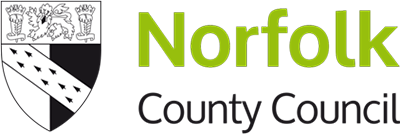Post 4 Will Teather – Revisiting the Paintings of Strangers’ Hall
The final piece that I have reinterpreted from the collections of Strangers Hall is a tudor portrait of Elizabeth D’Oyley, which is still drying in my studio.
As with all the works in this series, the patterns reference the underlying geometry that I felt was already implied within the historical composition, but I was particularly drawn to the decorative qualities of the original portrait and have tried to keep this spirit within my new version of the painting. The family crest in the top left hand corner is reimagined as a modernist emblem.
Once lockdown is over, I will compare my version more closely to the original, adjust the colours and add some additional glazes to add depth to the image. It will then be displayed at Strangers’ Hall with other artworks from this series, but for now you can see it here.
Cathy Terry, Senior Curator of Social History for Norfolk Museums Service, sheds some light on the history of the tudor artwork that inspired this painting:
Elizabeth D’Oyley aged 16, c 1608 by Robert Peake
The details of Elizabeth’s life are sketchy but from Kathy Lynn Emerson’s comprehensive study A Who’s Who of Tudor Women we learn that she was the daughter of Edmund D’Oyley of Shottisham, Norfolk and Catherine Neville (b.1570). In 1607 or 1608, she married Robert Buxton of Tibenham. A year or so later the couple had one child, a son, John (c.1609-1660). Robert died young on January 17, 1610/11 and John’s wardship was granted to Elizabeth and her father. Elizabeth’s second husband was William Perte of Mountnessing, Essex. By his first wife, Isabel Conyers, he already had a daughter, Margaret (c.1610-1686), but he had no children with Elizabeth D’Oyley. The inscription (added later) on the portrait by Robert Peake c.1608, is misleading. It seems to identify the Elizabeth d’Oyley as a Conyers co-heiress and the mother of Margaret Buxton. In fact, it is Margaret Perte, Elizabeth’s stepdaughter, who was the co-heiress. Margaret Perte became Margaret Buxton by her marriage to Elizabeth’s son, John. Portraits of both hang at Strangers’ Hall.
If we had to choose one painting to represent ‘beauty’ from our collections, Elizabeth d’Oyley would be our first choice. Painted at the age of sixteen, this young women on the threshold of womanhood was either newly married or about to be married, and her fragile beauty shines out. Queen Elizabeth I cultivated her own iconic style in her portraits and English representations of female beauty of the age all pay tribute to it. Her influence lasted well into the early Jacobean period and is seen in the volume and stiffness of the silhouette, and the predominance of jewelled decoration. The queen’s pale features and reddish hair had been widely imitated by members of the upper classes for several decades and the influence is still visible in Elizabeth d’Oyley’s portrayal by Robert Peake. In this formal, three quarter portrait she wears a deep red gown in expensive silk or velvet damask with drum farthingale and tight sleeves with lace. Her corset/ bodice appears to fasten at the front and has a dagged outer edge. Her starched fan collar is extremely fine and decorative. Elizabeth Doyley’s hair is swept up into a high padded beehive, at the top of which she wears a band adorned with floral jewels including a scarlet pimpernet, and a dianthus. A lavish triple gold chain is worn over her shoulder and a gold choker emphasise her wealth and high status.
The Buxton Portraits
In 1949 Norfolk Museum Service was bequeathed a remarkable series of portraits by Mrs Maud Buxton, the majority featuring various members of Norfolk branches of the Buxton family and dating back to the 16thcentury. The paintings arrived in the museum in two groups – one in 1949, and the other in 1963. Maud Buxton herself is also featured in a portrait in the same collection by Ralph Peacock ( NWHCM : 268.31 :F).
The Buxton paintings are to be found in Norwich Castle Museum and Strangers’ Hall, where the various family members adorn the walls of the Great Hall, the staircase and Lady Paine’s bedchamber. These enable us to make the visual links between mother, daughter-in-law, son and son’s wife. The well-known painting of the boy in a wheeled baby walker, known as Boy with Coral c. 1655 – 1660 (NWHCM : 1949.1381 F) also belongs to the collection.
Together the Buxton portraits reflect the fortunes of an extremely successful and publicly-focused family, as well as forming a comprehensive picture of fashions and hairstyles spanning over three hundred years. The challenge for both viewers and curators is to correctly ascribe a portrait to an individual, no easy task given that the majority of Buxton sons were either christened Robert or John, and several of the daughters were either Elizabeth or Anne. This was obviously tricky for the family too as one or two inscriptions are inaccurate. The family resemblance is down the generations is striking.
It seems that the Buxtons took the maxim ‘never throw anything away, you never know when it might come in useful’, much to heart, since in archive collections both national and locally, the Buxton presence is also writ large. A large collection is in Cambridge University Library, detailed here on the National Archives web-site:
https://discovery.nationalarchives.gov.uk/details/r/9dd58da9-f1f1-4486-b0df-29f2e60b4236
Throughout most of its history the Buxton family seemed to have a strong propensity to collect every document relating to its estates, personal and official affairs, preserving not only important documents such as deeds and estate records, but even quite trivial items such as invitations, memoranda or scraps of writings which had come to it or passed through its hands…….
The earliest records of the family begin with John Buxton junior (d. 1522) in 1464. Through careful land management and fortuitous marriages the family grew to be one of the major landowning families in East Anglia. Robert Buxton (d. 1528) acquired the manor of Channons, near Tibenham, Norfolk, by marriage to Christiana Glemham. His son John (1488-1572) built Channons Hall during the 1560s, which became the home of the Buxton family for the next 200 years. It was under Robert Buxton (c. 1533-1607) that the family rose to prominence. Robert entered the service of Thomas Howard, 4th Duke of Norfolk, as surveyor and solicitor in 1559, serving him until the duke’s death in 1572, before looking after the interests of his son Philip, Earl of Arundel. Following the fall of the Howards, Robert was appointed one of the government’s surveyor generals of the Howard lands in Norfolk and Suffolk, and received a licence to purchase their escheated property, Rushford College, in 1599.
Robert Buxton’s estate passed to his grandson Robert (1588-1611). Robert’s son, John Buxton (1608-1660), followed the family tradition by entering the legal profession, and by 1635 was a justice of the peace. As a lieutenant-colonel in the Norfolk militia, he was obliged to take part in the military exercises of the neighbourhood and to muster troops, although there is no evidence that he was involved in any military campaigns during the Civil War. On the death of Sir Francis Astley in May 1638 he became high sheriff of Norfolk. In 1656 John Buxton was elected M.P. for Norfolk, but, like other royalists, he was barred from taking up his seat in the Commons.
Credits The text above has been adapted from the following sources:
The National Archives
https://discovery.nationalarchives.gov.uk/details/r/9dd58da9-f1f1-4486-b0df-29f2e60b4236
A Who’s Who of Tudor Women, Kathy Lynn Emerson
https://discovery.nationalarchives.gov.uk/details/r/9dd58da9-f1f1-4486-b0df-29f2e60b4236
Fashion History Timeline https://fashionhistory.fitnyc.edu/1600-1609/
Supported by Arts Council England, Norfolk Arts Service and Norwich Arts Centre.
About Will Teather
Will Teather’s work has been exhibited internationally to acclaim, with recent exhibitions including New York’s RJD Gallery, Artwars at Red Dot?Miami?and as a finalist in the London Contemporary Art Prize.? His studio is based in Norwich, where he is?the Artist-in-Residence for Norwich Arts Centre, following on from previous residencies with venues in New York and Aberdeen.?
Further Information
Will Teather – www.willteather.com









